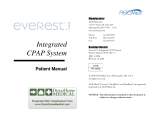
Page 6
11. Loops, Trends & Waveforms .................... 54
11.1 Waveforms............................................ 54
11.2 Loops .................................................... 55
11.2.1 Capturing, Retrieving & Deleting Loops.55
11.3 Trends................................................... 56
11.3.1 Minute Volume trend............................. 56
11.3.2 Description of Trend Windows .............. 56
12. Ventilator Set-up ........................................ 58
12.1 Preparing the Ventilator for Use............ 58
12.2 Ventilator Power Up and Power Down.. 60
12.2.1 Mains power indicator. .......................... 60
12.2.2 Powering up and down. ........................ 60
12.2.3 Turning ON the ventilator ...................... 60
12.2.4 Turning OFF the ventilator .................... 60
12.3 Back-up Battery Charging ..................... 60
12.4 Battery indicator .................................... 61
12.4.1 Explanation of battery charging. ........... 61
12.5 Suspension of the “Main Power Fail”
alarm. .................................................... 61
12.6 Extended storage .................................. 62
12.6.1 Screw cap fuse holder .......................... 62
12.6.2 Drawer type fuse holder........................ 62
13. Pre-use test ................................................ 64
13.1 Pre-use test checklist ............................ 65
14. Operational Considerations ..................... 68
14.1 General ................................................. 68
14.1.1 Ventilation Off Mode ............................. 68
14.1.2 CPAP Mode without a Flow Sensor and
with the Apnoea alarm set to “OFF”...... 68
14.1.3 SIMV Mode without a Flow Sensor and
with the Apnoea alarm set to “OFF ....... 68
14.1.4 Gas Input Pressures ............................. 68
14.1.5 Mode Memory On Power Up ................ 68
14.1.6 Backup Battery Power .......................... 68
14.1.7 Parameter Memory ............................... 69
14.1.8 BPM or Backup, Measured and Set
Parameters ........................................... 69
14.1.9 Tidal Volume Parameter Resolution ..... 69
14.1.10 Displayed O
2
%...................................... 69
14.1.11 HFO mode, Mean & Delta P
Parameters ........................................... 69
14.1.12 HFO variable I:E ratio ........................... 69
14.1.13 HFO Mean compensation ..................... 69
14.1.14 Breath Detection ................................... 70
14.1.15 Targeted Tidal Volume, Vte (TTV) ........ 70
14.1.16 Max Ti in PSV ....................................... 70
14.1.17 Wave Shaping....................................... 71
14.1.18 Flow sensor removal for suctioning or
re-calibration, pausing ventilation ......... 71
14.1.19 Flow sensor removal for suctioning or
re-calibration but continuing ventilation. 72
14.1.20 BPM Tot. Measurement. ....................... 72
14.2 Alarms................................................... 73
14.2.1 High and Low Alarm Operation ............. 73
14.2.2 Minute Volume Alarm Threshold........... 74
14.2.3 Tidal Volume Alarm Threshold.............. 74
14.2.4 Cycle Fail Alarm Threshold ................... 74
14.2.5 Sub-ambient Pressure Alarm in Non HFO
Modes ................................................... 74
14.2.6 HFO Only Ventilator Set Threshold Alarms
(SLE5000 only) ..................................... 74
14.2.7 Patient Leak Alarm ................................ 75
14.2.8 Reset Contamination Alarm .................. 75
14.3 Patient Circuits, Humidification and Nitric
Oxide Therapy....................................... 76
14.3.1 Autofeed Humidification chambers........ 76
14.3.2 Nitric Oxide Therapy ............................. 76
14.3.3 Nebulization of Medication ................... 77
15. Flow and Pressure Triggering ..................80
15.1 Breath Detection Threshold (Flow
Triggering)............................................. 80
15.2 Breath Trigger Sensitivity (Pressure
Triggering)............................................. 80
15.3 Setting the Pressure Trigger Level in CPAP,
SIMV, PTV and PSV ............................ 81
16. Basic Set-up ...............................................84
16.1 Pre set-up checks ................................. 84
16.2 Setting the O
2
% .................................... 84
16.3 CPAP Set-up......................................... 85
16.3.1 Actions after connection to patient in
CPAP .................................................... 85
16.3.2 Interactive and limiting controls in
CPAP .................................................... 85
16.3.3 TTV
plus
(Volume targeting) of backup
breaths in CPAP.................................... 86
16.3.4 Ventilation without a flow sensor
connected.............................................. 86
16.3.5 Ventilation with the Apnoea alarm turned
“OFF”..................................................... 86
16.4 CMV Set-up........................................... 87
16.4.1 Actions after connection to patient in
CMV ...................................................... 87
16.4.2 Interactive and limiting controls in CMV 87
16.4.3 TTV
plus
(volume targeting) all mechanical
breaths in CMV. .................................... 88
16.4.4 Ventilation without a flow sensor
connected.............................................. 88
16.5 PTV Set-up............................................ 89
16.5.1 Actions after connection to patient in
PTV ....................................................... 89
16.5.2 Interactive and limiting controls in PTV. 90
16.5.3 TTV
plus
(Volume targeting) of all triggered
and mechanical breaths in PTV. ........... 90
16.5.4 Ventilation Without a Flow Sensor
Connected............................................. 90
16.6 PSV Set-up ........................................... 91
16.6.1 Actions After Connection to Patient in
PSV ....................................................... 91
16.6.2 Interactive and limiting controls in PSV. 92
16.6.3 TTV
plus
(Volume targeting) of all triggered
and mechanical breaths in PSV. ........... 92
16.6.4 Ventilation Without a Flow Sensor
Connected............................................. 92
16.7 SIMV Set-up.......................................... 93

























